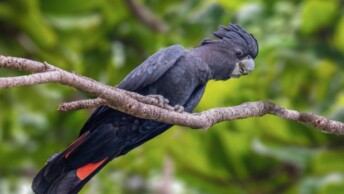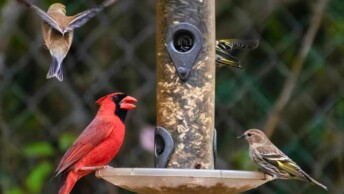Vermont’s skies are alive with the majestic presence of hawks, captivating bird enthusiasts and casual observers alike. These raptors, with their sharp talons and keen eyesight, dominate the state’s diverse landscapes, from dense forests to open fields.
Among the species, the Sharp-shinned Hawk and Cooper’s Hawk are agile hunters, navigating through wooded areas with remarkable speed. The larger Northern Goshawk remains elusive, often hidden in the state’s old-growth forests.
Vermont’s emblematic Red-tailed Hawk, recognized by its reddish tail, soars gracefully overhead, while the Broad-winged Hawk’s distinct whistling call signals the onset of migration. During winter, the Rough-legged Hawk, with its feathered legs, descends from the Arctic, and the Northern Harrier glides low over marshes.
These hawks, each with unique behaviors and habitats, contribute to the vibrant tapestry of Vermont’s natural world, offering a thrilling spectacle for all who witness their flight.
1. Red-Shouldered Hawk
- Scientific name: Buteo lineatus
- Life span: Up to 12 years
- Size: 18-20 inches (45-50 cm)
- Weight: 12-26 ounces (350-740 g)
- Wingspan: 40-48 inches (100-122 cm)
- Status: Least Concern
- State status: Breeding and uncommon
The Red-shouldered Hawk is a striking raptor that can be found in the eastern United States, including Vermont. This hawk boasts rich red barring on its chest and shoulders, contrasted with black-and-white checkered wings. Its tail is marked with narrow white bands.
Often heard before it is seen, the Red-shouldered Hawk’s distinctive “kee-aah” call echoes through forests and wetlands. This bird is particularly fond of habitats near rivers and streams, where its vibrant plumage and loud calls make it a prominent presence.

Red-shouldered Hawks typically choose wooded areas near water bodies for nesting. They build their nests in the crotches of tall trees, using sticks and lining them with softer materials like bark, leaves, and moss. Both male and female participate in nest construction.
The female lays 2-5 eggs, which she incubates for about 33 days while the male provides food. The chicks fledge around 6 weeks after hatching but continue to rely on their parents for food and protection for several more weeks.
Red-shouldered Hawks have a diverse diet that includes small mammals, amphibians, reptiles, and birds. They often hunt from a high perch, swooping down to capture prey with their sharp talons.
They are particularly fond of hunting in areas with water, such as swamps and marshes, where they can find frogs, snakes, and small fish. Their varied diet and hunting strategies make them adaptable to different environments, from forested areas to suburban landscapes.
Red-shouldered Hawks have benefited from conservation efforts aimed at protecting wetlands and forested habitats. Historically, they faced declines due to habitat destruction and pesticide use.
The establishment of protected areas and legal protections have helped stabilize their populations. Ongoing monitoring and research are essential to track their numbers and ensure their habitats are preserved.
2. Broad-Winged Hawk
- Scientific name: Buteo platypterus
- Life span: 12 years
- Size: 13.4-17.3 in (34-44 cm)
- Weight: 9.3-19.8 oz (265-560 g)
- Wingspan: 31.9-39.4 in (81-100 cm)
- Status: Least Concern
- State status: Migratory and common
The Broad-winged Hawk is a migratory raptor that graces the skies of North America, including Vermont, during the breeding season. With its compact size, broad wings, and distinctive tail bands, this hawk is a common sight during migration. Its plumage is brown above and pale below with horizontal barring on the chest.
During migration, Broad-winged Hawks form large flocks known as “kettles,” soaring in circles as they travel to their wintering grounds in South America. Their migration is a spectacular event that draws birdwatchers from far and wide.
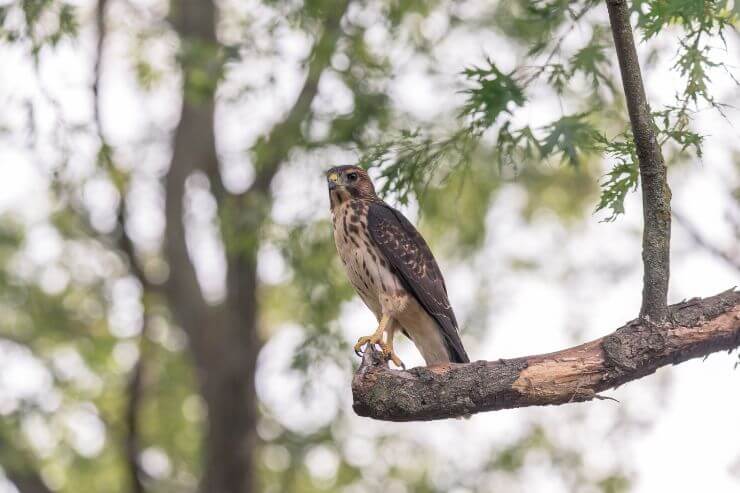
Broad-winged Hawks prefer dense forests for nesting, particularly deciduous woodlands. They build small, compact nests high in the trees, using twigs and leaves. Both sexes contribute to nest building, but the female is primarily responsible for incubation. She lays 2-3 eggs, which she incubates for about 28-31 days. The male provides food during this period. After hatching, the chicks remain in the nest for about 5-6 weeks before fledging.
The diet of Broad-winged Hawks consists mainly of small mammals, birds, and reptiles. They hunt from perches, scanning the forest floor for movement. Once prey is spotted, they swoop down swiftly to capture it. Their varied diet allows them to adapt to different environments within their range. During migration, their diet may shift depending on the availability of prey.
Broad-winged Hawks have been affected by habitat loss due to deforestation. Conservation efforts focus on preserving large tracts of deciduous forests, crucial for their nesting and hunting. Migration monitoring programs, such as Hawk Watch, track their numbers and migration patterns, providing valuable data for conservation planning.
3. Northern Goshawk
- Scientific name: Accipiter gentilis
- Life span: Up to 15 years
- Size: 24-29 in (61-74 cm)
- Weight: 1.5-3 lbs (680-1360g)
- Wingspan: 45-52 in (114-132 cm)
- Status: Least Concern
- State status: Breeding and rare
The Northern Goshawk is a large, formidable raptor found in the dense, mature forests of northern North America, including Vermont. It has a distinctive appearance with a slate-gray back, barred underparts, and a bold white stripe over its eyes.
This powerful bird is known for its fierce demeanour and agility in flight. The Northern Goshawk prefers secluded, thickly wooded areas, making it a rare sight for birdwatchers. When spotted, its robust build and striking plumage make it an unforgettable encounter.
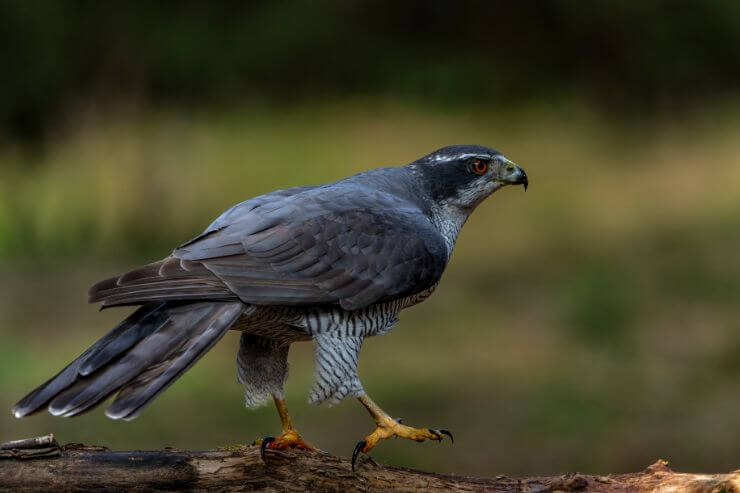
Northern Goshawks prefer remote, mature forests for nesting, selecting large trees to build their nests high above the ground. The nest is a robust structure made of sticks and lined with bark and greenery. They may use the same nest site for multiple years or build new ones nearby.
The female lays 2-4 eggs, which she incubates for around 30-32 days. The male supplies food during incubation. Chicks fledge about 35-46 days after hatching but stay with their parents for several more weeks, honing their hunting skills.
Northern Goshawks have a varied diet that includes birds, mammals, and occasionally reptiles and insects. They are formidable hunters, capable of taking down prey as large as hares and grouse. In forested habitats, they use their agility to maneuver through trees, surprising their prey.
They also hunt from perches, watching and waiting for the perfect moment to strike. This adaptability in diet and hunting technique allows Northern Goshawks to thrive in diverse environments, from dense forests to open woodlands.
Northern Goshawks faced significant challenges from deforestation and hunting in the past. Conservation efforts have focused on protecting large tracts of mature forests, essential for their nesting and hunting. In some regions, reforestation projects have helped restore suitable habitats. Monitoring programs track their population trends, and legal protections aim to reduce hunting pressures.
4. Rough-Legged Hawk
- Scientific name: Buteo lagopus
- Life span: Up to 15 years
- Size: 18-20 in (46-51 cm)
- Weight: 1.5-3.25 lbs (680-1470g)
- Wingspan: 52-54 inches (132-137 cm)
- Status: Least Concern
- State status: Migratory and uncommon
The Rough-legged Hawk is a winter visitor to North America, including Vermont, migrating from the Arctic tundra. This hawk is well-adapted to cold climates, with feathers that extend down its legs, giving it its name. It has a pale head, dark belly, and strikingly patterned wings that are dark at the edges.
Seen often hovering over open fields, the Rough-legged Hawk is a majestic sight against the winter landscape. Its broad wings and tail, marked with dark bands, make it easily distinguishable from other raptors.

Rough-legged Hawks nest in the Arctic tundra, selecting cliffs and rocky outcrops for their nesting sites. They construct their nests using sticks, lining them with grasses, moss, and feathers to provide insulation. Both parents participate in building the nest. The female lays 2-7 eggs, which she incubates for about 31 days.
During this period, the male is responsible for hunting and bringing food to the nest. After hatching, the chicks fledge in about 5-6 weeks but remain near the nest site, relying on their parents as they learn to hunt.
Rough-legged Hawks primarily feed on small mammals, such as lemmings and voles, especially during the breeding season in the Arctic. They are versatile hunters, capable of capturing prey on the ground or in flight. During winter migration, their diet expands to include other small mammals like mice and shrews, as well as birds. They are known for their distinctive hunting technique of hovering in place, allowing them to spot and swoop down on unsuspecting prey from above.
Rough-legged Hawks have benefitted from conservation efforts aimed at protecting their breeding habitats in the Arctic and their wintering grounds in North America. These efforts include habitat preservation and monitoring programs to track population trends.
Historically, they faced threats from habitat loss and climate change, but increased awareness and protective measures have helped stabilize their populations. Ongoing research and conservation initiatives continue to play a crucial role in ensuring the survival of these remarkable raptors.
5. Northern Harrier
- Scientific name: Circus hudsonius
- Life span: Up to 12 years
- Size: 18-20 inches (45-50 cm)
- Weight: 12-26 ounces (350-740 g)
- Wingspan: 40-48 inches (100-122 cm)
- Status: Least Concern
- State status: Breeding and uncommon
The Northern Harrier is a unique raptor known for its low, gliding flight over marshes and open fields in North America, including Vermont. With a distinctive owl-like facial disc and a white rump patch, the Northern Harrier is easily recognizable. Males are gray above and white below, while females are brown with streaked underparts.
This bird’s long wings and tail help it maneuver gracefully as it hunts close to the ground. Often seen flying with its wings held in a V-shape, the Northern Harrier is a captivating sight for birdwatchers.
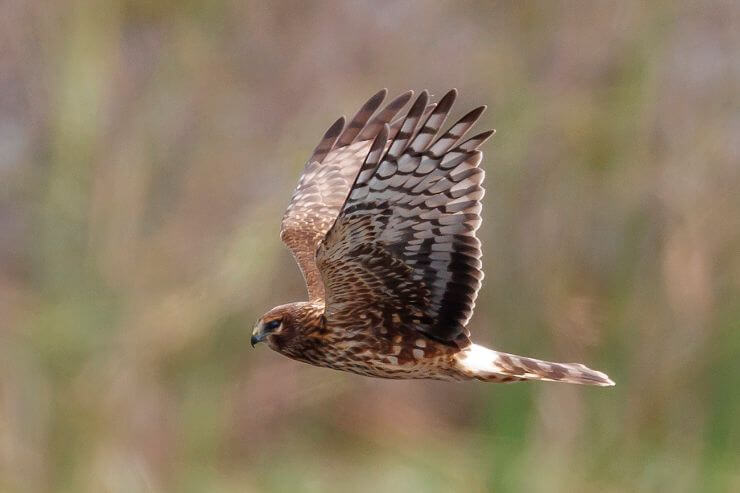
Northern Harriers are unique among hawks for their ground-nesting habits. They choose marshes, wetlands, and grasslands for their nesting sites, building nests from reeds, grasses, and sticks. The nests are well-concealed within dense vegetation to protect them from predators.
The female lays 4-5 eggs, which she incubates for about 30-32 days. The male provides food during this period, often having multiple mates simultaneously. After hatching, the chicks fledge in about 30-35 days but stay with their parents for a few more weeks as they develop their hunting skills.
Northern Harriers have a varied diet, primarily consisting of small mammals, birds, and amphibians. They hunt by gliding low over fields and marshes, using their keen eyesight and acute hearing to locate prey. Their owl-like facial discs help direct sound to their ears, enhancing their ability to hunt by sound. This hunting technique makes them highly effective predators in open landscapes.
Conservation efforts for Northern Harriers focus on protecting their habitats, particularly wetlands and grasslands, which are critical for their nesting and hunting. Historically, they have faced threats from habitat destruction and pesticide use. Wetland preservation and restoration projects have been crucial in supporting their populations. Monitoring programs help track their numbers and health, ensuring that conservation measures are effective.
6. Cooper’s Hawk
- Scientific name: Accipiter cooperii
- Life span: 12 years
- Size: 14.6-15.3 in (37-39 cm)
- Weight: 7.8-14.5 oz (220-410 g)
- Wingspan: 24.4-35.4 in (62-90 cm)
- Status: Least Concern
- State status: Breeding and common
Cooper’s Hawk is a medium-sized raptor commonly found throughout North America, including Vermont. With its blue-gray back, rusty-barred underparts, and striking red eyes, the Cooper’s Hawk is a sight to behold. Juveniles have a more subdued appearance with brown streaks and yellow eyes.
This hawk is adept at maneuvering through forests and suburban areas, making quick, agile flights to catch its prey. Often seen perching silently or flying low through wooded areas, the Cooper’s Hawk’s stealth and speed are remarkable.

Cooper’s Hawks build their nests in tall trees, often within deciduous or mixed forests. They prefer secluded areas but can also adapt to urban settings. Both male and female participate in nest building, using sticks and lining the nest with softer materials.
The female lays 3-5 eggs, incubating them for about 34-36 days. The male provides food during this period. Once hatched, the young remain in the nest for about four to five weeks, gradually learning to hunt under their parents’ guidance before becoming fully independent.
Cooper’s Hawks primarily prey on medium-sized birds, such as doves, pigeons, and songbirds. They are skilled hunters, using speed and surprise to catch their prey, often pursuing them through dense foliage. They may also eat small mammals, including squirrels and rabbits. In urban areas, Cooper’s Hawks are known to visit bird feeders, taking advantage of the abundance of prey. Their adaptable diet helps them thrive in various environments, from deep forests to suburban backyards.
Cooper’s Hawks were once heavily persecuted due to their predation on poultry. With changing attitudes and better understanding of their ecological role, conservation efforts have focused on habitat protection and reducing human-wildlife conflicts. The banning of harmful pesticides and the establishment of protected areas have aided their recovery.
Urbanization has also surprisingly provided new opportunities for these adaptable hawks. Monitoring and research continue to ensure that Cooper’s Hawks maintain healthy populations across their range.
7. Red-Tailed Hawk
- Scientific name: Buteo jamaicensis
- Life span: 10-15 years
- Size: 19.7-25.6 in (50-65 cm)
- Weight: 31.8-51.5 oz (900-1460 g)
- Wingspan: 44.9-52.4 in (114-133 cm)
- Status: Least Concern
- State status: Breeding and common
The Red-tailed Hawk is one of North America’s most familiar raptors, found throughout the continent and common in Vermont. Its most distinctive feature is its rich, red tail, which stands out against its brown back and pale underparts. The bird’s broad wings and short, wide tail make it easy to identify in flight.
Often seen soaring high or perched along roadsides, the Red-tailed Hawk’s loud, raspy scream is unmistakable. This adaptable bird thrives in various habitats, from deserts to forests, making it a versatile and resilient presence.
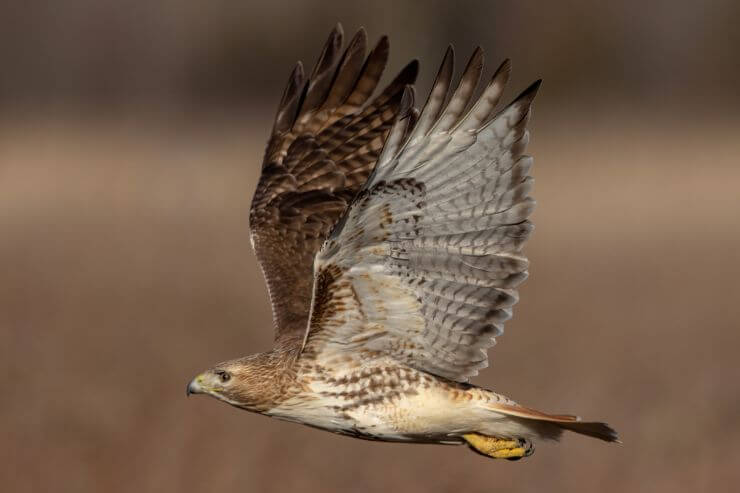
Red-tailed Hawks prefer open areas with scattered trees or forest edges for nesting. They build large, sturdy nests high in trees or on cliff ledges, using sticks and lining them with softer materials like bark and leaves. Both male and female participate in nest building.
The female lays 1-3 eggs, which she incubates for about 28-35 days. The male provides food during incubation. The chicks fledge around 6-7 weeks after hatching but remain dependent on their parents for several more weeks.
Red-tailed Hawks have a broad diet that includes small to medium-sized mammals, birds, and reptiles. They are often seen soaring high in search of prey or perched on tall structures like telephone poles. Their keen eyesight allows them to spot prey from great distances. They use their powerful talons to capture and kill their prey. This adaptability in diet makes them one of the most successful and widespread hawks in North America, thriving in various habitats from deserts to forests.
Red-tailed Hawks have benefited from extensive conservation efforts, including legal protections and habitat preservation. Historically, they faced threats from hunting and habitat destruction. Today, they are one of the most common raptors in North America, thanks to successful conservation measures. Monitoring programs continue to track their populations, ensuring they remain stable.
8. Sharp-Shinned Hawk
- Scientific name: Accipiter striatus
- Life span: 5 years
- Size: 9.4-13.4 in (24-34 cm)
- Weight: 3.1-7.7 oz (87-218 g)
- Wingspan: 16.9-22.1 in (43-56 cm)
- Status: Least Concern
- State status: Breeding and common
The Sharp-shinned Hawk is a small but fierce raptor found across North America, including the dense forests of Vermont. Sporting a slate blue back and reddish barring on its chest, this hawk is easily recognizable. Its eyes, bright yellow in juveniles and deep red in adults, give it a piercing gaze.
This agile hunter is often seen darting through the forest canopy or perched quietly, watching for prey. Its long, slender legs and squared-off tail distinguish it from similar species, making it a unique presence in Vermont’s avian landscape.

Sharp-shinned Hawks prefer dense forests for their nesting sites, often choosing coniferous trees that provide ample cover. The nests are built by both sexes, typically placed 20-60 feet above the ground.
They use sticks and twigs, lining the nest with finer materials. The female lays 3-8 eggs, which she incubates for about 30 days. The male’s role during this period is primarily to provide food. The chicks fledge about three weeks after hatching, but they remain dependent on their parents for several more weeks, learning essential survival skills.
Sharp-shinned Hawks primarily feed on small birds, making them adept hunters in forested environments. They utilize surprise and swift, agile flights to catch their prey, often targeting songbirds like sparrows and finches. Occasionally, they may also hunt small mammals, insects, and reptiles. Their sharp talons and keen eyesight aid in capturing and subduing prey, making them efficient predators despite their small size. During migration, they may adjust their diet based on available prey, showcasing their adaptability.
Historically, Sharp-shinned Hawks faced significant population declines due to habitat loss and pesticide use, particularly DDT. Conservation efforts have since improved their numbers. The banning of DDT and protection of their habitats have been crucial in their recovery.
Monitoring programs and bird counts help track their population trends, ensuring they remain a common sight in their preferred habitats. Continued efforts focus on preserving forested areas and minimizing human disturbances to maintain their population stability.
Where to find Hawks in Vermont
To spot hawks in Vermont, head out with binoculars and a field guide during early mornings or late afternoons. Four prime locations for hawk watching include Mount Philo State Park, where you can see migrating Broad-winged Hawks from the summit, and Dead Creek Wildlife Management Area, a hotspot for Northern Harriers. Missisquoi National Wildlife Refuge along Lake Champlain offers sightings of Red-shouldered Hawks, while Green Mountain Audubon Center in Huntington provides excellent views of Cooper’s Hawks and Sharp-shinned Hawks.
Each location offers a unique habitat, from marshlands to dense forests, ensuring a thrilling birdwatching experience. Remember to remain patient and quiet to increase your chances of spotting these magnificent raptors.
Conclusion
Vermont’s diverse landscapes offer a rich habitat for a variety of hawk species. From the elusive Northern Goshawk to the adaptable Red-tailed Hawk, these raptors are integral to the state’s natural beauty. By protecting their habitats and continuing conservation efforts, we ensure these magnificent birds thrive for future generations.

